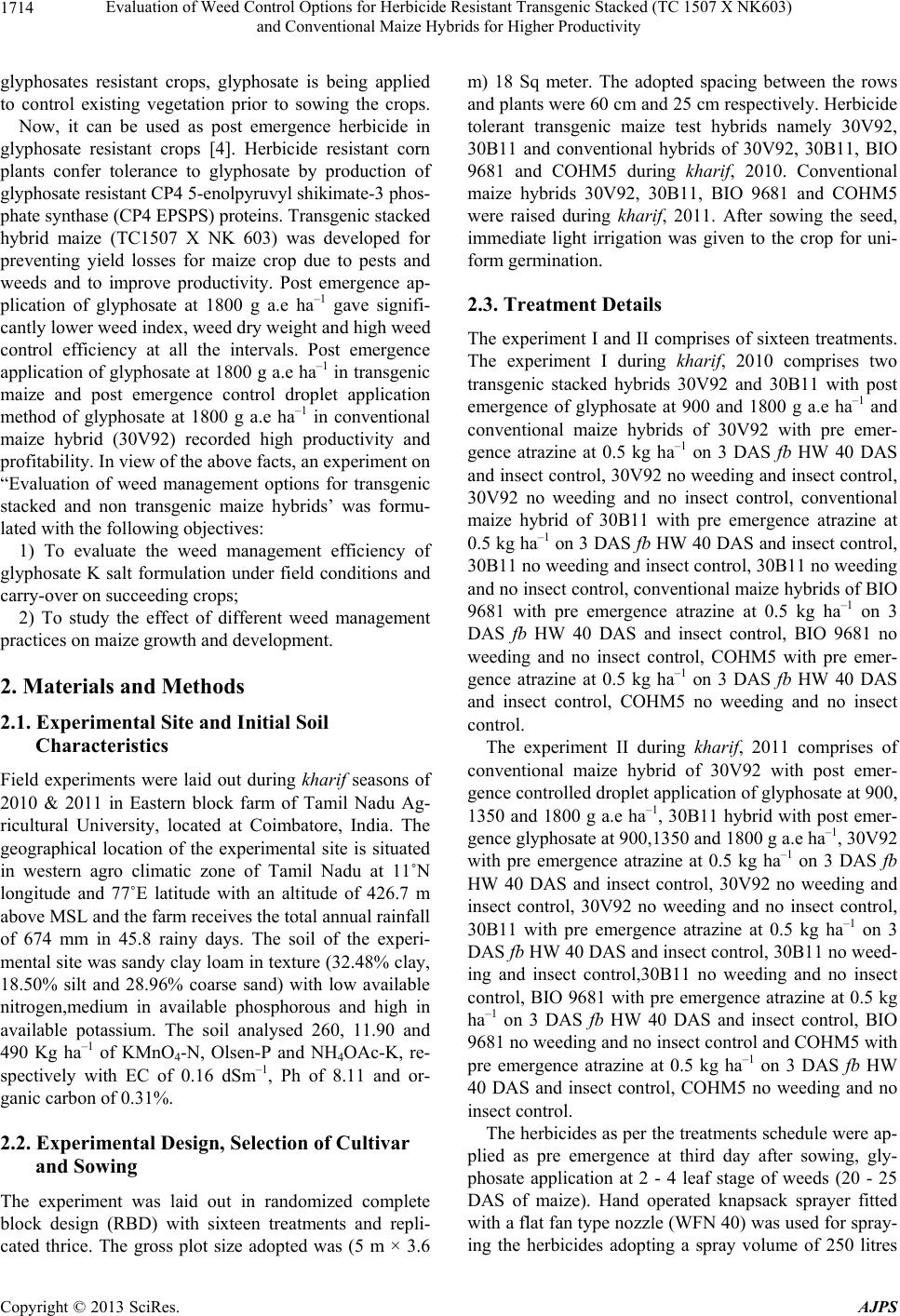
Evaluation of Weed Control Options for Herbicide Resistant Transgenic Stacked (TC 1507 X NK603)
and Conventional Maize Hybrids for Higher Productivity
1714
glyphosates resistant crops, glyphosate is being applied
to control existing vegetation prior to sowing the crops.
Now, it can be used as post emergence herbicide in
glyphosate resistant crops [4]. Herbicide resistant corn
plants confer tolerance to glyphosate by production of
glyphosate resistant CP4 5-enolpyruvyl shikimate-3 phos-
phate synthase (CP4 EPSPS) proteins. Transgenic stacked
hybrid maize (TC1507 X NK 603) was developed for
preventing yield losses for maize crop due to pests and
weeds and to improve productivity. Post emergence ap-
plication of glyphosate at 1800 g a.e ha–1 gave signifi-
cantly lower weed index, weed dry weight and high weed
control efficiency at all the intervals. Post emergence
application of glyphosate at 1800 g a.e ha–1 in transgenic
maize and post emergence control droplet application
method of glyphosate at 1800 g a.e ha–1 in conventional
maize hybrid (30V92) recorded high productivity and
profitability. In view of the above facts, an experiment on
“Evaluation of weed management options for transgenic
stacked and non transgenic maize hybrids’ was formu-
lated with the following objectives:
1) To evaluate the weed management efficiency of
glyphosate K salt formulation under field conditions and
carry-over on succeeding crops;
2) To study the effect of different weed management
practices on maize growth and development.
2. Materials and Methods
2.1. Experimental Site and Initial Soil
Characteristics
Field experiments were laid out during kharif seasons of
2010 & 2011 in Eastern block farm of Tamil Nadu Ag-
ricultural University, located at Coimbatore, India. The
geographical location of the experimental site is situated
in western agro climatic zone of Tamil Nadu at 11˚N
longitude and 77˚E latitude with an altitude of 426.7 m
above MSL and the farm receives the total annual rainfall
of 674 mm in 45.8 rainy days. The soil of the experi-
mental site was sandy clay loam in texture (32.48% clay,
18.50% silt and 28.96% coarse sand) with low available
nitrogen,medium in available phosphorous and high in
available potassium. The soil analysed 260, 11.90 and
490 Kg ha–1 of KMnO4-N, Olsen-P and NH4OAc-K, re-
spectively with EC of 0.16 dSm–1, Ph of 8.11 and or-
ganic carbon of 0.31%.
2.2. Experimental Design, Selection of Cultivar
and Sowing
The experiment was laid out in randomized complete
block design (RBD) with sixteen treatments and repli-
cated thrice. The gross plot size adopted was (5 m × 3.6
m) 18 Sq meter. The adopted spacing between the rows
and plants were 60 cm and 25 cm respectively. Herbicide
tolerant transgenic maize test hybrids namely 30V92,
30B11 and conventional hybrids of 30V92, 30B11, BIO
9681 and COHM5 during kharif, 2010. Conventional
maize hybrids 30V92, 30B11, BIO 9681 and COHM5
were raised during kharif, 2011. After sowing the seed,
immediate light irrigation was given to the crop for uni-
form germination.
2.3. Treatment Details
The experiment I and II comprises of sixteen treatments.
The experiment I during kharif, 2010 comprises two
transgenic stacked hybrids 30V92 and 30B11 with post
emergence of glyphosate at 900 and 1800 g a.e ha–1 and
conventional maize hybrids of 30V92 with pre emer-
gence atrazine at 0.5 kg ha–1 on 3 DAS fb HW 40 DAS
and insect control, 30V92 no weeding and insect control,
30V92 no weeding and no insect control, conventional
maize hybrid of 30B11 with pre emergence atrazine at
0.5 kg ha–1 on 3 DAS fb HW 40 DAS and insect control,
30B11 no weeding and insect control, 30B11 no weeding
and no insect control, conventional maize hybrids of BIO
9681 with pre emergence atrazine at 0.5 kg ha–1 on 3
DAS fb HW 40 DAS and insect control, BIO 9681 no
weeding and no insect control, COHM5 with pre emer-
gence atrazine at 0.5 kg ha–1 on 3 DAS fb HW 40 DAS
and insect control, COHM5 no weeding and no insect
control.
The experiment II during kharif, 2011 comprises of
conventional maize hybrid of 30V92 with post emer-
gence controlled droplet application of glyphosate at 900,
1350 and 1800 g a.e ha–1, 30B11 hybrid with post emer-
gence glyphosate at 900,1350 and 1800 g a.e ha–1, 30V92
with pre emergence atrazine at 0.5 kg ha–1 on 3 DAS fb
HW 40 DAS and insect control, 30V92 no weeding and
insect control, 30V92 no weeding and no insect control,
30B11 with pre emergence atrazine at 0.5 kg ha–1 on 3
DAS fb HW 40 DAS and insect control, 30B11 no weed-
ing and insect control,30B11 no weeding and no insect
control, BIO 9681 with pre emergence atrazine at 0.5 kg
ha–1 on 3 DAS fb HW 40 DAS and insect control, BIO
9681 no weeding and no insect control and COHM5 with
pre emergence atrazine at 0.5 kg ha–1 on 3 DAS fb HW
40 DAS and insect control, COHM5 no weeding and no
insect control.
The herbicides as per the treatments schedule were ap-
plied as pre emergence at third day after sowing, gly-
phosate application at 2 - 4 leaf stage of weeds (20 - 25
DAS of maize). Hand operated knapsack sprayer fitted
with a flat fan type nozzle (WFN 40) was used for spray-
ing the herbicides adopting a spray volume of 250 litres
Copyright © 2013 SciRes. AJPS